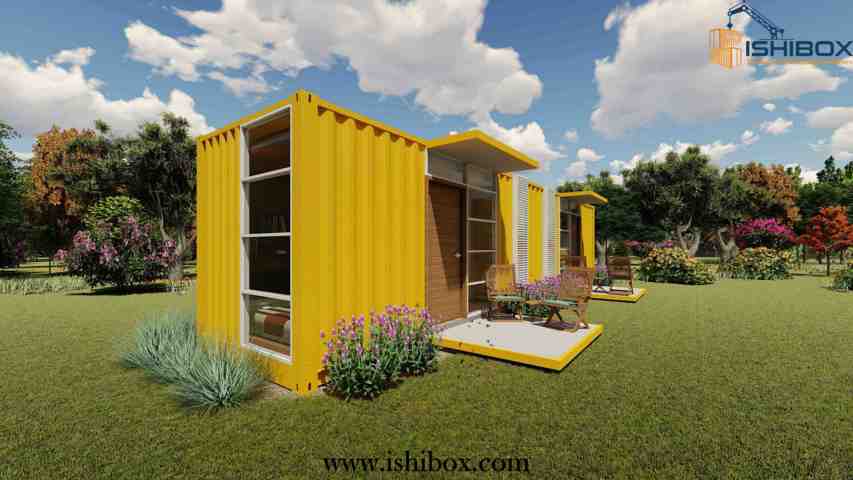Today we’ll look at how to properly insulate a shipping container home. Shipping containers have evolved from just being transportation tools to efficient shipping container homes. But in order for such a transformation to be complete, the containers need to be insulated. This will give them the perfect finish and allow for climate control.
The types of insulation available for shipping containers vary depending on many other factors which you shall learn more about below. Before we get into these types of container insulation, let’s first understand what is insulation.

Definition of Insulation
This is a type of material whose sole purpose is to allow for climate control. It does this by preventing heat energy from escaping through the walls, floor, or ceiling of the container. It will trap air and maintain the temperatures within the structure. Unlike other elements, air conducts thermal energy the poorest making them the best insulators.
Reasons for Insulating a Shipping Container
While it may not be mandatory to insulate the shipping container home while inhabiting it, it comes highly recommended. The top reasons to insulate your shipping container home are:-
- To allow for climate control. Steel has one of the highest thermal conductivity. Hence, it will reflect the same energy outside to within the container. In extreme heat, it will be extremely hot and vice versa.
- For decorative purposes. The exterior look of steel is not at all pleasant when it comes to living inside it.
- Noise transition. Any click on the steel will be heard even three times louder on the inside. With insulation, the noise will be relatively low.
- Safety and security. People are afraid to move into shipping container homes because they don’t fit into the comfort and safety criteria of a brick and mortar house. With insulation, it will all be the same.

Factors to Consider When Choosing Insulation for Your Container Home
Like everything else we buy, the value or worth of it is not the same. You need something that works for you in all aspect. With that in mind, let’s look at some of the factors to consider before making the decision to insulate.
Ecological Reasons
The type of insulation you add to your space should be environmentally friendly. Just to reflect on the key aspects of shipping container homes.
Read more on the Pros and Cons of Shipping Container Homes.
Performance
Insulation features characteristics such as the materials used, how the gas will be trialed for heat control and the structure. Keep a close eye into such small details.
R-Value
A very important factor is how well the insulator will be able to prevent loss of heat energy. This also goes along with the interior spacing. How much space will the insulation take considering containers have fixed sizes.
Air and Vapor Leakage
This overlooks how air or vapor will be flowing in and out through the insulation. How well can it prevent any leakages?
Cost
The better quality will always cost you more than something ordinary. But you can choose something less expensive and it will serve you for longer.

Types of Shipping Container Insulation
There are six ways in which you can insulate a shipping container home or structure. These types of insulation include:-
- Blanket insulation
- Loose-fill insulation
- Expanded foam insulation
- Polyurethane foam insulation
- Polystyrene insulation
- Spray foam insulation
Blanket Insulation
Much like the blanket you use, they work under the mechanism of filling up spaces using fiber for the fuller and warmer environment. This type of insulation is easily fitted into the spacing to add to its durability. They are a cheap option plus they come readily available for such jobs.
Examples of blanket insulation include:-
- Fibreglass Insulation
Fiberglass insulation made from heated sand and recycled glass. Offers one of the highest RV values.
- Wool
This can be made from rocks, mineral, slab or a sheepskin. Using renewable and natural materials they are highly eco-friendly. They also offer high performance with an RV value of 3.5 per inch. Plus their hygroscopic fibers have an ability to absorb over 35 percent of its weight in water without any thermal problems.
In terms of chemical safety, they are flame retardant which saves you the cost of having to teat the wool with additional chemicals. There are different types of sheep’s wool depending on the manufacturer.
- Cotton
Very warm and conducive material for extreme temperatures, this type of insulation features a new evolution of denim jeans. These recycled jeans have an R-Value of 3.5 per inch, similar to that of more traditional fiberglass insulation.
Unlike wool, denim insulation requires to be treated with boric acid, a natural fire retardant. The denim insulation doesn’t have a good vapor permeability. It cannot resist water densities as it takes a very long time to completely dry out
General cotton insulation, however, has a favorable RV value, it is permeable to vapor and a good choice for just about any type of insulation. The disadvantage with such is that they are quite expensive. They can be irritating to the skin or cause allergies, especially fiberglass insulation.
Loose-Fill Insulation
This insulation is slightly slimmer than the blanket insulation. It involves applying macroscopic chunks into the wall cavity to fill out any spaces. This insulation requires the wall cavity to be filled completely for ultimate coverage or insulation value will not be performance efficient.
Examples of this insulation include:
- Loose-fill fiberglass – less dense than the original fiberglass.
- Cellulose – made from recycled materials such as papers that have been shredded and blown into place by a machine. The machine will add water a form of damp spraying to attach the cells together.
- Perlite – also known as vermiculite. These are minerals that have been heated like rice pads and filled up like balloons to completely fill the wall cavities.
This type of insulation is more vapor permeable but has a less RV value than the blanket insulation.
Expanded Foam Insulation
Made away from the construction site, this insulation features large panels percent for ceiling heights. It can be self-supporting, unlike the blanket insulation. For this insulation, holes will be made on the doors and windows by cutting.
The expanded foam is ineffective in that the gas from the closed cell over time will start to escape causing a loss in the RV value. This type of insulation can be installed with ways. By attaching to the studs or by gluing to the container.
Other times, the expanded foam can be molded in a way they will correlate with the corrugated sheets on the container. Otherwise, large air spaces may be left out. It is very easy to install hence DIY friendly and had the highest RV value per inch compared to other insulation materials.
Polyurethane foam (PU)
Foam is yet another way to insulate your home. PU specifically offers two varieties to choose from. Some of which include:
- Open Cell Variety – has a lower RV value due to inadequate space-filling that gives off a spongy texture.
- Closed Cell – using a blowing agent, this type of foam fills the spaces with microscopic cells. Filled with plenty of air. It has a higher RV value as air is a good insulant.
- Cementitious foam – this is one light concrete mixture that resembles polystyrene foam. Similar in RV value, they offer good insulation but could have a rather awful texture. Especially after being cured.
Polystyrene foam
Another type of foam that can be used to insulate a shipping container home, different in texture and RV value. This foam also has different types. They include:
- Extruded (EPS) – they are made from plastic beads combined to form an air shield.
- Expanded (XPS) – the material has to be molten to enable shaping into sheets for coverage.
- Polyisocyanurate (Polyiso) – very similar to PU, but offers greater durability and RV strength.
Spray Foam Insulation
Very easy to install is the spray foam. It is created in a way it will form a monolithic attached piece of foam which can further be expanded into the cracks, nooks, and crannies of the container.
Delicate attention is needed in the edge to allow for trimming of the over-expanded foam that pushes right past the studs. They also have a favorable RV value, but due it being a closed cell structure, air can easily leave the foam reducing the rigidity.
The major advantage of this type of insulation is that it can be applied both on the interior and exterior walls. They have a high resistance to strong paint specifically those used to coat shipping containers.
They are best known to trap any toxic chemicals from the paint that could cause emissions of any poisonous gas.
It is, however, important to take precaution since you may be allergic or have any other reactions with the foam. A good example of this foam is Icynene.
It is a water-blown spray foam insulation that expands the further it hardens, therefore, protecting the home like small plastic bubbles coating. The coating works perfectly and provides adequate insulation after two or three weeks.

Conclusion
Insulation is very important for a shipping container home. While the temperatures vary over seasons and geographic locations, getting the best insulation is what is best for your home.
If you have any queries, experts at Ishibox Limited can advise you more on how to insulate a shipping container home depending on your budget and specifications.






Recent Comments